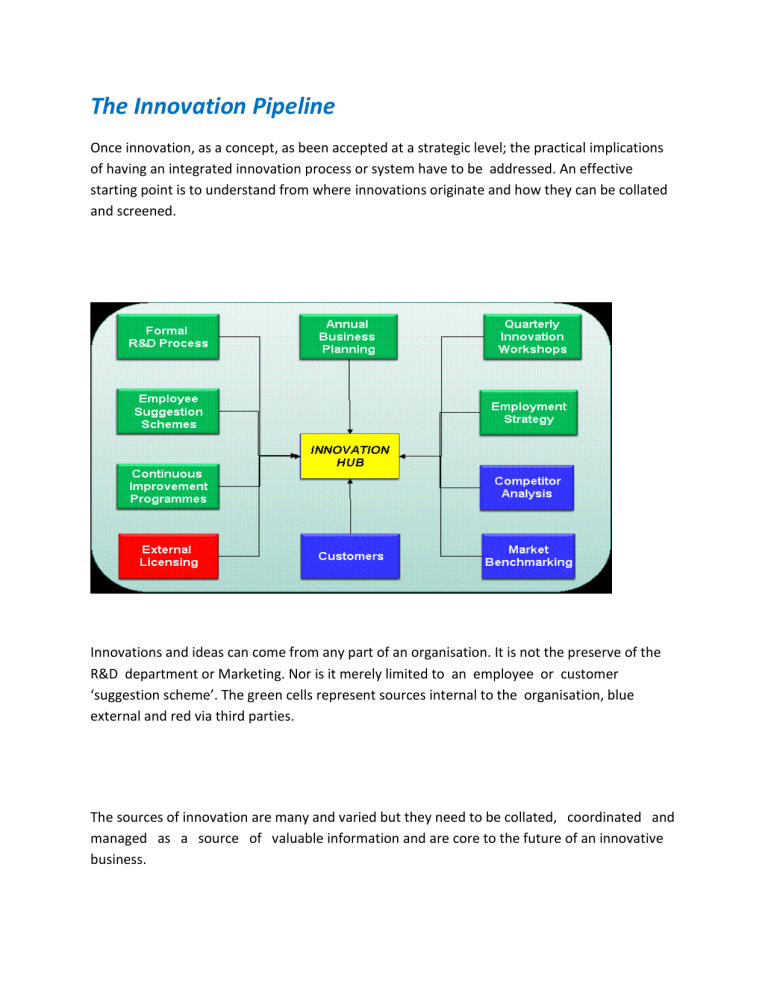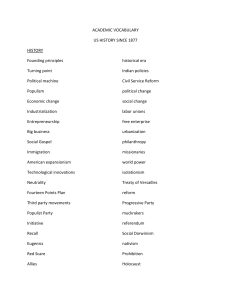The Innovation Process

The Innovation Pipeline
Once innovation, as a concept, as been accepted at a strategic level; the practical implications of having an integrated innovation process or system have to be addressed. An effective starting point is to understand from where innovations originate and how they can be collated and screened.
Innovations and ideas can come from any part of an organisation. It is not the preserve of the
R&D department or Marketing. Nor is it merely limited to an employee or customer
‘suggestion scheme’. The green cells represent sources internal to the organisation, blue external and red via third parties.
The sources of innovation are many and varied but they need to be collated, coordinated and managed as a source of valuable information and are core to the future of an innovative business.
A successful innovation culture embraces all aspects of a business and should be managed as effectively and efficiently as any other core business process. To that end, successful innovation companies operate an ‘Innovation Hub’ where all ideas and innovations are collated and coordinated.
Creative processes and analysis can be used to stimulate new ideas in four basic areas:
Business Innovation – new business or supply chain models, for example
Product or service Innovation – new or modified products or ways of providing a
service
Market Innovation – opening a new market or creating a new customer base
Process Innovation – improving or changing internal processes
Ideas should be effectively screened and ‘bad’ ideas killed off quickly but sympathetically.
The number and type of ideas will be determined by the ‘performance gap’ and available resources. Many organisations find that an effective screening or filtering process prevents ‘innovation overload’ whereby a company is almost paralysed by the sheer volume of innovations and ideas generated from the multiplicity of sources previously mentioned.
If new ideas and innovations are to make a difference, they must satisfy five basic criteria captured in the V-SAFETM screening process :
Value – does the idea deliver tangible benefits to the organisation? This questions helps eliminate those ideas and innovations that are good in principle but add little or no value to the bottom line, now or in the future. ‘Tangible’ means that proponents of the idea or innovation will have to estimate or calculate the specific benefits that will arise.
Suitable – is it consistent with strategy and the current situation? This helps eliminate those ideas that are potential distractions and move the business needlessly away from its core business focus. If an idea or innovation is not ‘suitable’ it still may have value, but in
other ways – such as outsourcing it under licence to third parties or even spinning it off as a separate product within a separate business entity!
Acceptable – will all stakeholders support it? Often innovations fail in large companies because of the ‘not invented here’ syndrome. It is crucial that proponents of an idea or innovation spend time and effort on selling the idea internally and gauging the level of support for it. This is often overlooked and failures are often attributed to ‘office politics’.
Stakeholders are an internal barrier that must be negotiated as if they were a formal process.
Feasible – are there sufficient resources and time? Can the innovation be managed within existing budgets or will additional funding be required? Do new skills need to be acquired to implement this idea effectively? The answers to these questions will affect the timeline for implementation and the potential return on investment calculation.
It is often seen as a reality check.
Enduring – will the idea deliver value in both the long and short term? If a new idea or innovation is to be truly strategic will it survive the rigours of time? Is the long term gain worth the short term pain of bringing a new idea to market? Again this highlights the return on the investment to be made.
The Innovation Process
Innovation should be built into business routines at three distinct levels – at the Annual
Business Planning (ABP) process, through structured ‘themed’ Quarterly Innovation
Workshops (QIWs), and ad hoc day to day activities. Some of the routines are ‘proactive’ by nature – a conscious focus on bringing ideas and concepts forward into the innovation process
– such as ABP meetings and QIWs. Some routines are ‘passive’ or ‘reactive’, such as creating a culture of innovation where day to day activities and management seek to enable innovations to flourish.
In all cases ideas and innovations should be driven by market, customer or competitor insights (MCIs) and progress reviewed on a monthly basis. A robust project management process is often a prerequisite for effective implementation and communication.
There are a few critical success factors when installing and running an innovation process within any organisation :
• A focus on opportunities of high value – and lesser ideas are discarded quickly. This is done through a robust and widely known filtering process using the V-SAFE process, or similar.
• Active commitment of top management – through visible leadership and use of the process by senior management. As soon as an ‘informal’ process to fast track ideas from senior management is used the innovation process breaks down.
• Build techniques into business processes – the most successful innovation cultures are those where the core innovation process is as natural as all other business processes such as budgeting and planning. Easy to state – difficult to do!
• Develop innovation as a core skill – in all staff and especially in managers! It can be done and managers can be encouraged to put forward their and their staff’s ideas. Thinking innovatively is a skill that can be acquired.
• Tools to support the application of concepts – using the internet and some tracking software ideas can be tracked and innovations planned. You would not think of running any other core business process without a tool or system of some sort – so why should innovation be different?
• Reward people for sharing ideas & knowledge – and this does not just mean a cash bonus!
Performance can be improved through good management and a reward system that recognises group effort and sharing ideas rather than just the individual.
• Communicate successes – though all means possible. Let people know how innovative their colleagues are. Communication is the lifeblood of the process and is essential for positive reinforcement of good practice.





